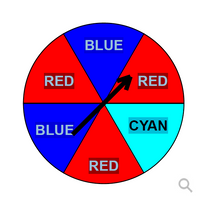
A First Course in Probability (10th Edition)
10th Edition
ISBN: 9780134753119
Author: Sheldon Ross
Publisher: PEARSON
expand_more
expand_more
format_list_bulleted
Concept explainers
Topic Video
Question
The spinner below is spun twice. If the spinner lands on a border, that spin does not count and spin again. It is equally
likely that the spinner will land in each of the six sectors.
For each question below, enter your response as a reduced fraction.
Find the
Find the probability of spinning cyan on the first spin and cyan on the second spin.
If the spinner is spun twice, find the probability of spinning red at least once.

Transcribed Image Text:This image depicts a color wheel divided into five sections of varying colors:
- Two sections are labeled "BLUE" and are colored blue.
- Two sections are labeled "RED" and are colored red.
- One section is labeled "CYAN" and is colored cyan.
An arrow is pointing towards one of the "RED" sections. The sections are arranged in alternating colors around the wheel. The diagram could be used to illustrate concepts such as probability or random selection.
In an educational context, this diagram could serve as a tool for teaching about ratios, chance, and outcomes in a simple and visual way, by spinning the wheel to see which color it lands on.
Expert Solution
This question has been solved!
Explore an expertly crafted, step-by-step solution for a thorough understanding of key concepts.
This is a popular solution
Trending nowThis is a popular solution!
Step by stepSolved in 4 steps

Knowledge Booster
Learn more about
Need a deep-dive on the concept behind this application? Look no further. Learn more about this topic, probability and related others by exploring similar questions and additional content below.Similar questions
- In a class of 65 students, 20 are nursing majors, 16 are parents, and 5 of the nursing majors are parents. If one student is randomly selected from the class, find the probability of choosing a nursing major or a parent. Write your answer as a simplified fraction. The probability of choosing a nursing major or a parent isarrow_forwardFind the probability of getting a 2, 4, 5, or 6 when you roll a standard six-sided diearrow_forwardThere are 50 tickets sold for a raffle for a Student ArtAuction, and there is one prize to be awarded. If Diontebuys a ticket, find the odds that he’ll win.arrow_forward
- Help Please: Find the probability of “2 pair” (a hand that contains two cards of one rank, two cards of anotherrank and one card of a third rank).arrow_forwardAt bedtime, you read three books to your kids, Walker, Michael, and Luke. Together, they have 32 books. If you decide to randomly choose three books, what is the probability that the three you choose will consist of each of their favorite books? Assume they have different favorites. Express your answer as a fraction in lowest terms or a decimal rounded to the nearest millionth.arrow_forwardYou draw one card from a 52 card deck. Find the probability of drawing a queen or a red card.arrow_forward
arrow_back_ios
arrow_forward_ios
Recommended textbooks for you
 A First Course in Probability (10th Edition)ProbabilityISBN:9780134753119Author:Sheldon RossPublisher:PEARSON
A First Course in Probability (10th Edition)ProbabilityISBN:9780134753119Author:Sheldon RossPublisher:PEARSON

A First Course in Probability (10th Edition)
Probability
ISBN:9780134753119
Author:Sheldon Ross
Publisher:PEARSON
